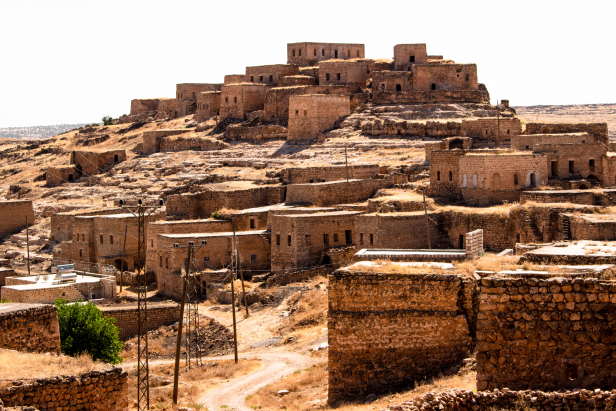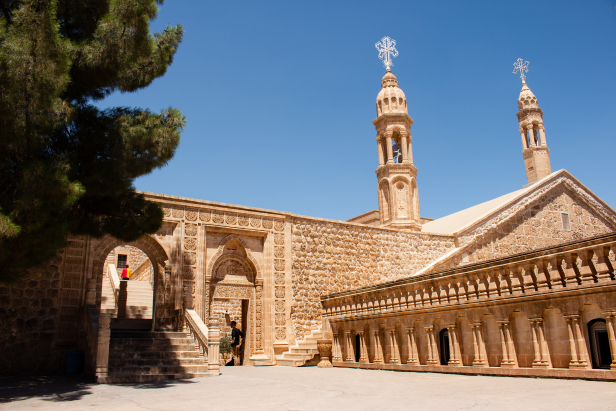Syriac Churches, Monasteries, and Villages of Tur Abdin
Tur Abdinde Suryani Manastırları, Kiliseleri, ve Köyleri
/ By Josh
Cost: Most sights are free, though donations are appreciated.
Great for: Architecture, Village Life, Ancient Churches, Religious History
Christianity spread quickly throughout the Roman and Persian Empires following the death of Christ in the first century, though it saw most of its growth in the urban centers while the rural populations held out in their pagan beliefs. Tur Abdin was one of these rural areas that remained pagan while churches were built and bishops appointed in the surrounding cities. It wasn’t until the 4th century that monks would arrive and change the social fabric of the region.
The name Tur Abdin, meaning “mountains of the Servants”, was used to describe this hilly region even before the arrival of Christianity. With the adoption of Christianity in the 4th century the name Tur Abdin took on a new significance and was understood as “the Mountains of the Servants of God” with the building of numerous monasteries and churches.

The Christian inhabitants of Tur Abdin are often refered to as ‘Syriac’ though there is no universally agreed upon term. Assyrian, Aramean, and Chaldean are also used though they all have slightly different connotations. The people speak a somewhat modernized form of Aramaic, the language spoken by Jesus and the people of the first century Church.
Subscribe to The Art of Wayfaring
While the influence of Christianity (as well as that of the Syriac Christians themselves) waned over the centuries following the arrival of new Islamic rulers, the edifices of the Christian faith have survived even when the Christian population itself had to abandon their ancestral lands in the face of persecution and war. Here in Tur Abdin, there are the remains of churches and monasteries dating back well over 1000 years. While some are ruins, many ancient buildings have been restored by the combined effort of those Syriacs who have remained in the area and those who fled persecution to Europe but return to keep their language, culture, and homes alive.
Recommended reading:
TURABDIN (ISBN 3-9501039-0-2) by Hans Hollerweger – 367 pgs
If you can find it (we were given ours by the bishop at Mor Gabriel) this would be my recommended pick for a book with TONS of detailed information regarding off the beaten path places. All copies are German, English, and Turkish which is really helpful for trying to figure out place names in a tri-lingual region.
MONK AND MASON ON THE TIGRIS FRONTIER (ISBN 0521360269) by Andrew Palmer – 289 pgs
Though this book takes a detailed and rather academic approach it covers a broad range of sites thoroughly and may be useful to anyone who wants to take a more in-depth look at the Tur Abdin region and its unique history.
Why Visit?
While there are many other villages, churches, and remote monasteries with histories, locals, and architecture worth a visit, below is a selection of the sites that we have visited. If you’d like more information on any places not included in this list we’d recommend the above mentioned books, or feel free to contact us.
With the exception of a couple of the more touristic sites, all of these places are free of cost to visit though we’d highly recommend giving a donation in the church. These ancient buildings are sometimes all that remains of a local population and maintaining these ancient buildings is not cheap. Your donation can help preserve a history that has survived against many difficulties.
The Town of Midyat
As one of the chief cities of Tur Abdin there is a great deal to see in Midyat. The old town is a maze of old stone streets and walls with a surprisingly rural feel (and smell) despite the size of the town. Many households in old Midyat are walled with courtyards. Most windows open to the courtyard rather than into the street making for a rather unusual feel to the town. Rising above the stone walls you’ll see belltowers, marking the location of the towns numerous churches. Services rotate from church to church so if you’d like to attend a service make sure to find out in advance where it will be held.

Midyat is also home to the Syriac Telkari, or filigree, artists. These craftsman make art and jewelry out of fine silver wire, keeping alive a long-standing tradition. While the craftsmen have traditionally been Syriac, people of other ethnicities have also learned under the guidance of the old masters and are continuing the trade.
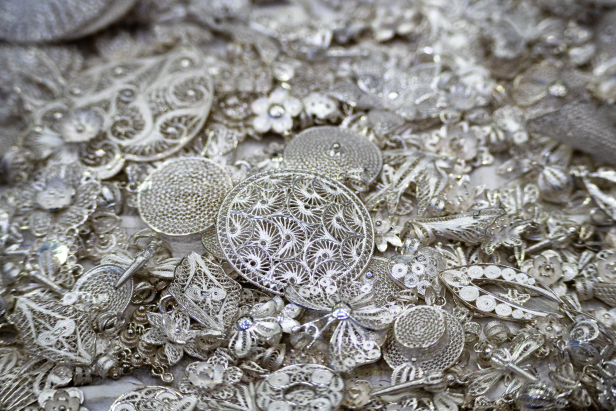
Tur Abdin is one of Turkey’s few wine producing regions; its local Christians having kept vineyards here for centuries. The best place to taste some of the local vintages is here in Midyat by either buying a bottle from one of the local wine shops or visiting a wine house and opening a bottle in an ancient stone mansion. The Syriac people who produce the wine here are known as Suryani in Turkish, a name often associated with wine in Turkey.
Churches to visit: Mor Ahisnoyo, Mor Barsamo, Mor Hobil, and Mor Abrohom Monastery just outside of Midyat.
For more, read our full Guide to the Town of Midyat.
Mor Gabriel
One of the chief monasteries of the Syriac community of Tur Abdin, the Monastery of Mor Gabriel is a sprawling complex of new and ancient blended together. The monastery with its high stone walls sits amid an oasis in an otherwise barren landscape, with green fields and orchards maintained to feed the people connected to the monastery and its operation.
The lowest levels of Mor Gabriel are ancient, with portions dating back to the 4th century. There are crypts and domed chambers from the early 6th century. The stunning Byzantine style mosaics of the apse date back to the 6th century as well. On top of the ancient structures (repaired often following the destruction brought by Mongols, Timurids et al.) there are more modern buildings. Some built to house the Syriacs who visit seasonally for weddings, funerals, as well as religious and linguistic education.
Today Mor Gabriel is the center of Syriac Orthodoxy in the land of its origin and houses a number of monks and nuns and clergy.
For more, read our full Guide to the Monastery of Mor Gabriel.
Doğançay (Turkish) Mozizah (Aramaic)
The village of Mozizah is seven kilometers south of Midyat along the Cizre road that passes by Mor Gabriel. Much of the village is abandoned though it is still very picturesque. In the midst of the village is the church of Mor Yuhanon, a relatively small church with additional rooms for teaching. The bell tower is a modern addition.
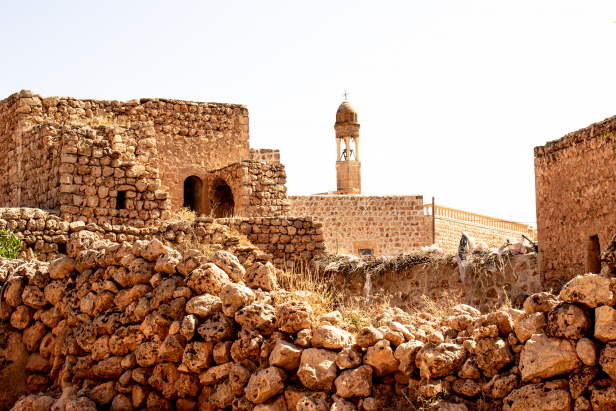
Bağlarbaşı (Urdnus) Church of Mor Kyriakos
The church of Mor Kyriakos at Urdnus is a large, decently well maintained church though without any Syriac population remaining in the village, it is difficult to visit unless you come in the summer when the Syriacs of Urdnus come from Europe. While the church is maintained, the last priest left in 1991 and no bell tower was added.

Urdnus, or Bağlarbaşı as it is shown on most maps, is east of Midyat, on the road to Kfarza and on to Hah (Anıtlı in Turkish).
Altıntaş (Turkish) Kfarza (Syriac) Church of Mor Izozoel
Just east of Urdnus/Bağlarbaşı is the sizable village of Kfarza, known in Turkish as Altıntaş. There are a number of smaller chapels and hermitages, but the greatest draw is the church of Mor Izozoel. The church was built sometime between the 6th and 8th centuries though it has been badly damaged and repaired multiple times over the centuries. British traveller Gertrude Bell stopped here in 1909; her photos capture some of the changes that the church has undergone in just the last century. During the events of WWI and the massacres of the Syriac population of the Ottoman Empire the church roof was badly damaged and partially collapsed. The names of those who contributed to its repair are written in Syriac script in the ceiling.
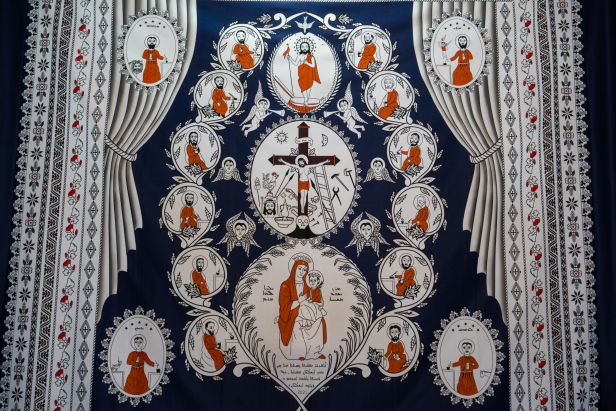

Anıtlı (Turkish) Hah (Aramaic) and Meryemana (Turkish) Yoldath Aloho (Aramaic)
While the village of Hah is somewhat small and remote, it is home to one of Turabdin’s most beautiful churches. The Church of Yoldath Aloho, with its intricately decorated apse and unusual dome structure covered in fine niches was Tur Abdin’s first bishopric and the town’s greatest attraction. Beyond this church there other churches and monasteries as well as ancient houses and a unique fortress.
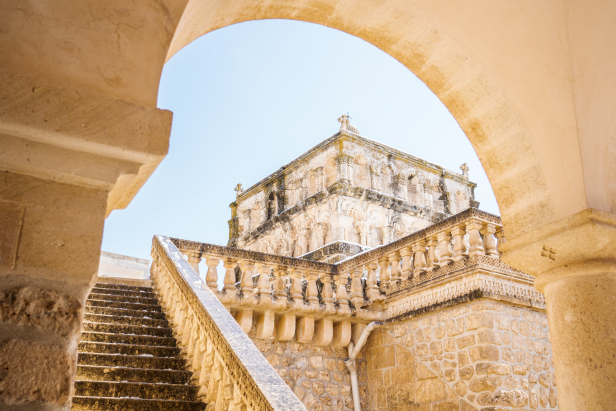
For more details read the whole Guide to The Church of Yoldath Aloho and the Village of Hah (Anıtlı).
Mercimekli (Habsus)
The village of Habsus (or Mercimekli in Turkish) is just north-east of Midyat and is home to a large Syriac Church though, as of 2022, the Syriac population has dwindled down to a single elderly man. The Church of Mor Shemun D’Zeyte is quite large and in good repair. It was founded by Mor Shemun who earned the epithet D’Zeyte, (Olive) by planting thousands of olive trees while he was bishop of Harran in the year 700.
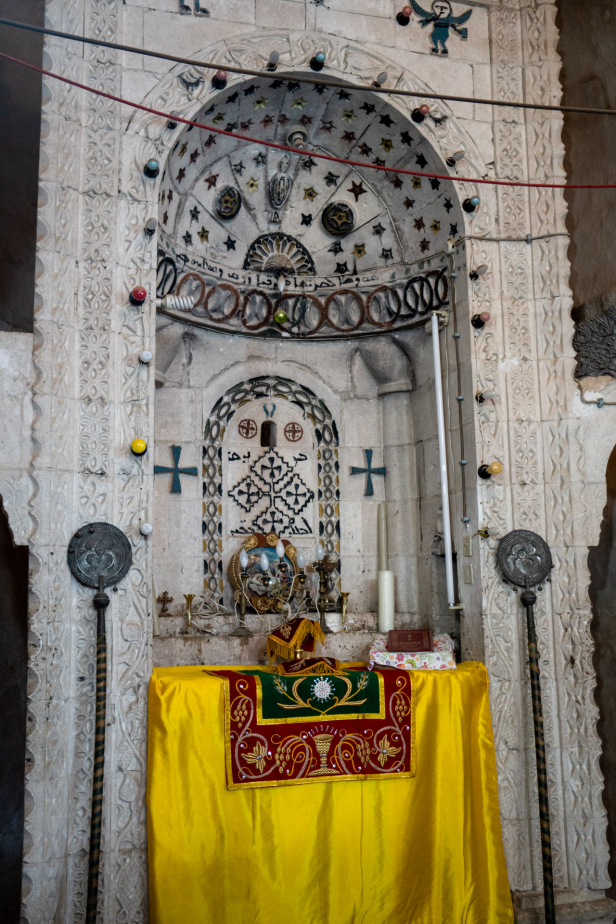
On the edge of the village is the ruined Monastery of Mor Loozor. While there are elements that date back to the 5th century, this monastery was also founded by Mor Shemun D’Zeyte. The monastery is abandoned and can be accessed through the front gate or the gap in the outer wall where it has collapsed. The complex is fairly large with numerous rooms and two storeyed buildings. Most interesting of all however is the large pillar standing in the midst of the courtyard. The pillar was once used by a stylite, a monk who practiced an extreme form of asceticism and lived atop a pillar. The pillar at Mor Loozor is the only confirmed stylite pillar in Tur Abdin, though it is possible that the Monastery of Mor Serkis and Mor Bakus in the Village of Hah may have had such a monk.
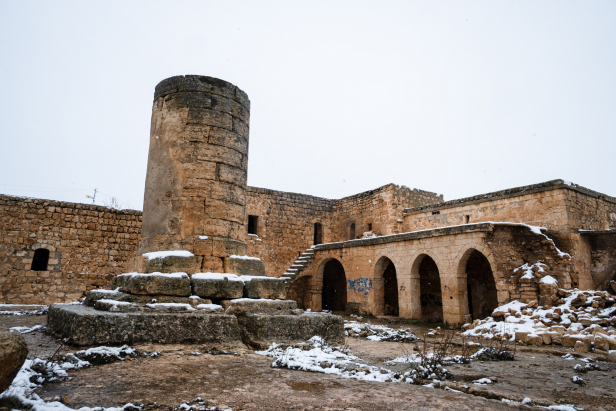
Mor Augin/Mor Avgin/Mor Evgin
Note: We have not visited this site in person but didn’t want to exclude this particularly beautiful site from this list.
Mor Augin is probably one of the most beautiful ruined monasteries in the Tur Abdin region. Located on Mount Izlo between Dibek and Günyurdu it sits perched on the steep slopes overlooking the Nusaybin plain. Founded in the fourth century it grew into a wide complex before being abandoned centuries later. Restoration work has been carried out in recent years.
Gülgöze (Inwardo, Aynverd, Aynwardo, Aynvardo) and the Church of Mor Had Bshabo
A small hilltop village, Inwardo is dominated by the church of Mor Had Bshabo, which looks more like a small fortress with its pair of round turrets, than a church. Only in the last century was a bell tower added, making clear that this is in fact a place of worship. This fortified church and the village played a key role in the more recent history of the Syriac people of Tur Abdin.

In 1915 during the persecution of Christian minorities throughout the Ottoman Empire, thousands of Syriacs of Tur Abdin took refuge in the village of Inwardo. Some estimates put the number of refugees at nearly 22,000. The Syriacs were prepared for the attack and were able to defend themselves throughout a sixty day siege while in other places the Syriac people were massacred.
Today you can still see bullets lodged into the walls of the church of Mor Had Bshabo.

Deyrul Zafaran
Thanks to its location just seven kilometers outside of the city of Mardin, the Monastery of Deyrul Zafaran is perhaps the best known and most visited Syriac site on this list. Deyrul Zafaran, meaning “House of Saffron” sits on a picturesque slope, surrounded by a ridge of mountains on three sides. From below you can see the doors and windows of abandoned chapels and hermitages carved in the cliffs above.
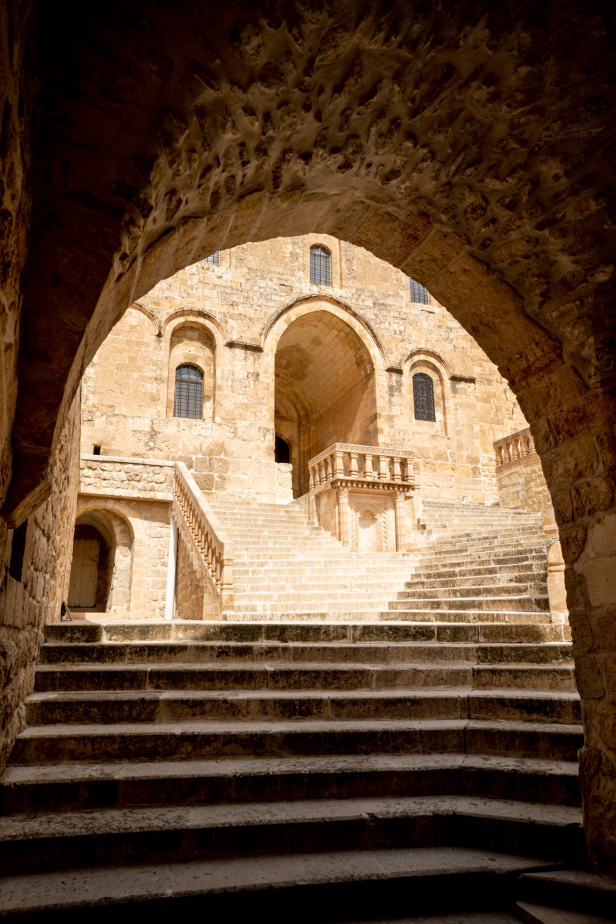
The monastery building itself has a unique history that predates Christianity. In the basement of the monastery there is a room with a remarkable flat fault of fitted stones, defying gravity for over 2000 years. The oldest of the monastic structures are the church and the crypt which have been dated to the 6th century and are built with particularly beautiful stonework.
The high outer walls of the monastery that greet visitors as they arrive are more recent additions, some of which is made up of dorm-like rooms for guests.
For more details read the whole Guide to The Monastery of Deyrul Zafaran.
How To Get There
General
While you can reach some of Tur Abdin’s many sights by public transit, you’ll be limited to only a few as well as difficulties with the timing of busses not lining up efficiently. We’d strongly recommend renting a car to explore the scattered sights of Tur Abdin.
For more about car rental and driving in Turkey make sure to read our full drivers guide.
Where To Stay
There are only two really good options for where to stay in the area of Tur Abdin and Eastern Mardin. While Mardin is quite restive compared to some of the neighbouring provinces (and the neighbouring country of Syria to the south), police may still eye you with suspicion in some of the more remote parts of the province. Your best options are to stay in the City of Mardin itself, or in the Town of Midyat. Midyat is right in the heart of the Tur Abdin area and is still large enough to have a decent selection of hotels to choose from ranging from cheap to high end boutique hotels in historic mansions. While there are some small hotels in Nusaybin, this is a border town to Syria and you may end up with the police asking a whole lot more questions than if you were to stay in more “normal” towns like Midyat and Mardin.
Other Tips
The summer here is very hot and dry (frequently over 40 degrees Celsius). Coming in the spring will allow you to beat the worst of the heat and see the sites while they’re set in the beautiful though short-lived greenery. While not common, Tur Abdin does get cold enough in the winter to get some snow.
Planning on visiting the Syriac Churches and Villages of Tur Abdin? Make sure to check out our other guides to the sights of Mardin Province and Turkey’s East!
Subscribe to The Art of Wayfaring
Have any tips or info to add? Spot any mistakes? We’d love to hear about it.
